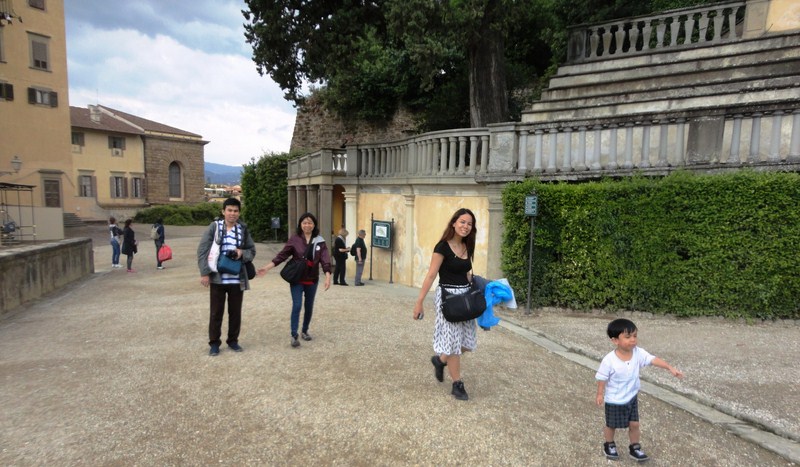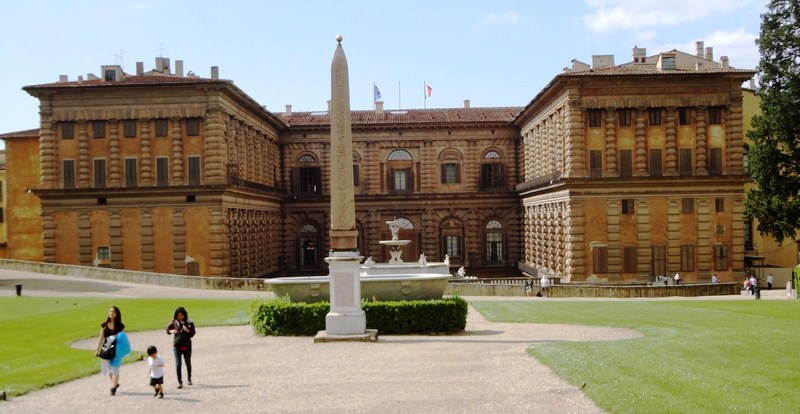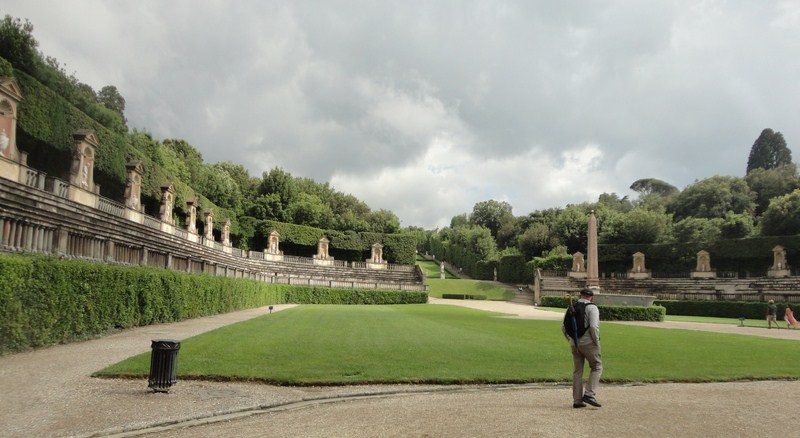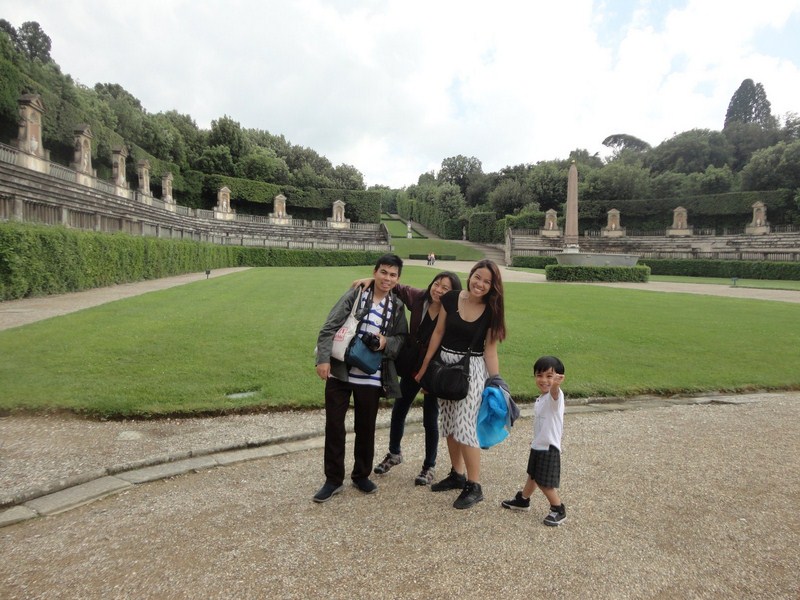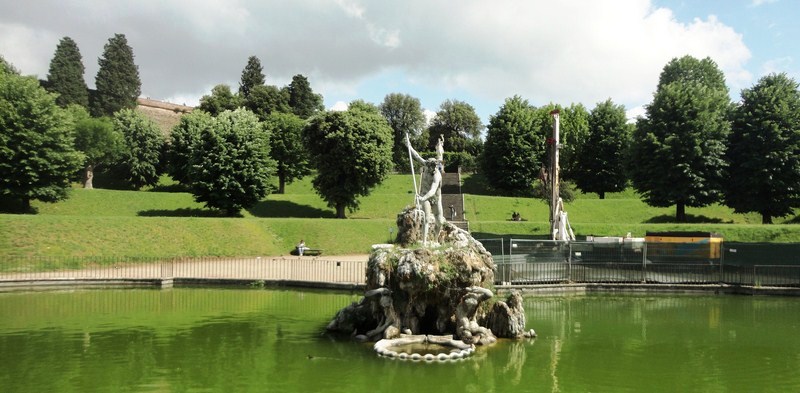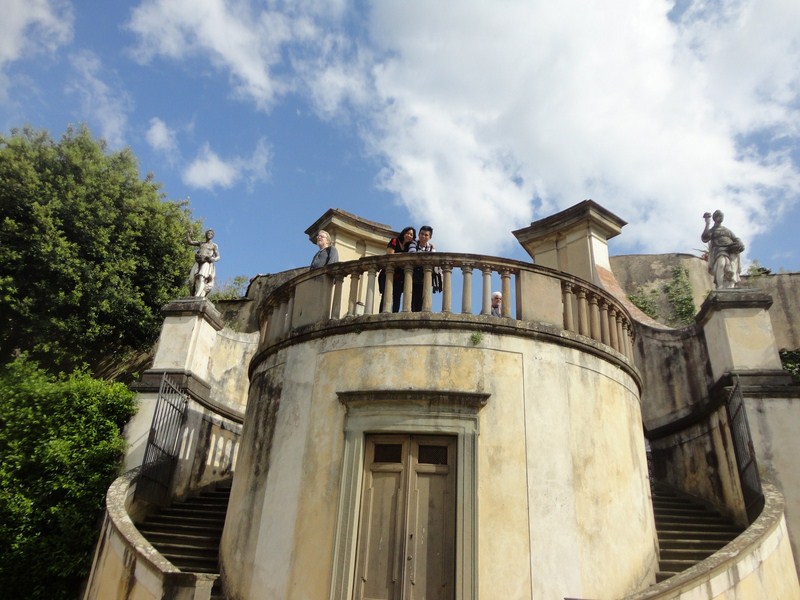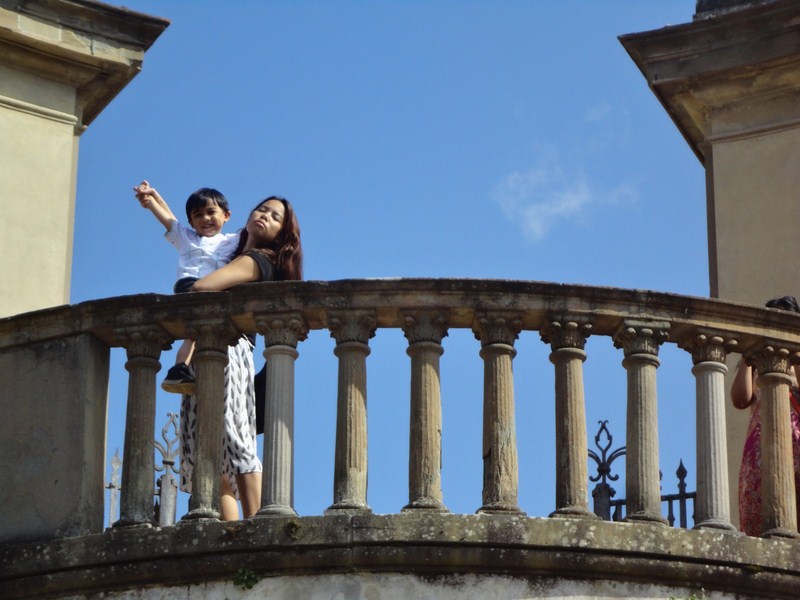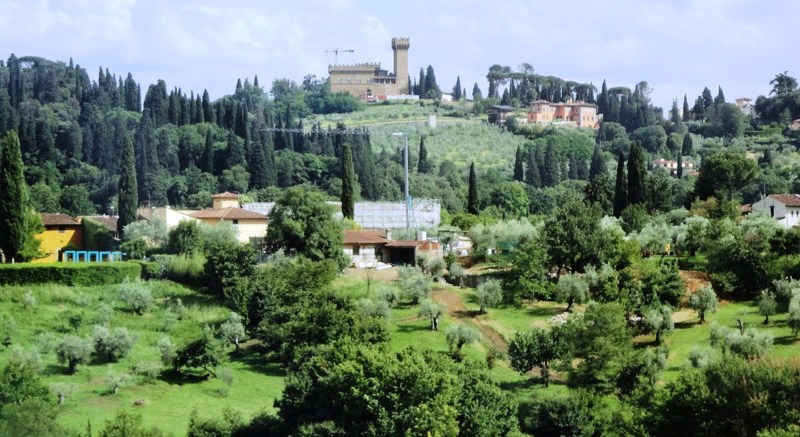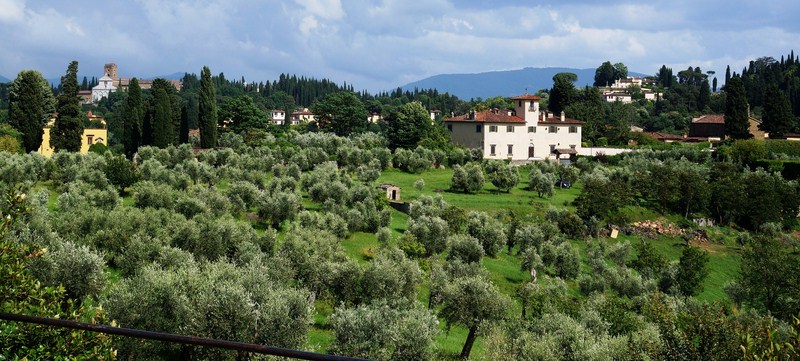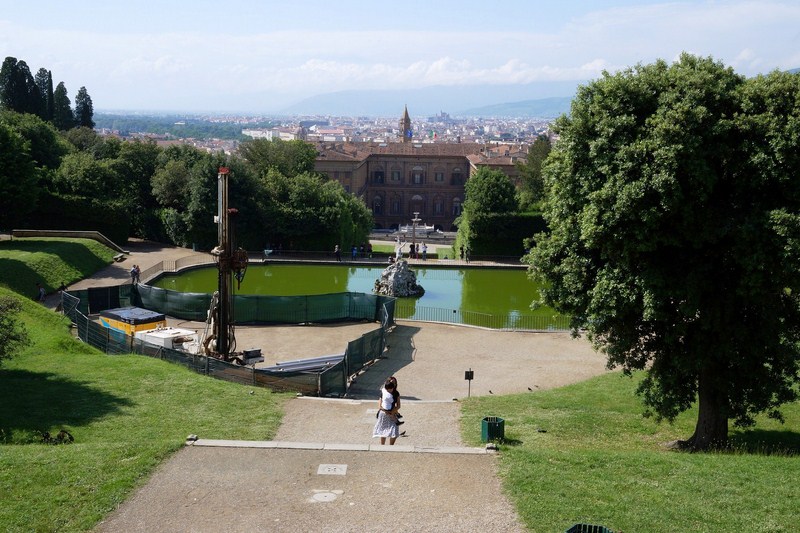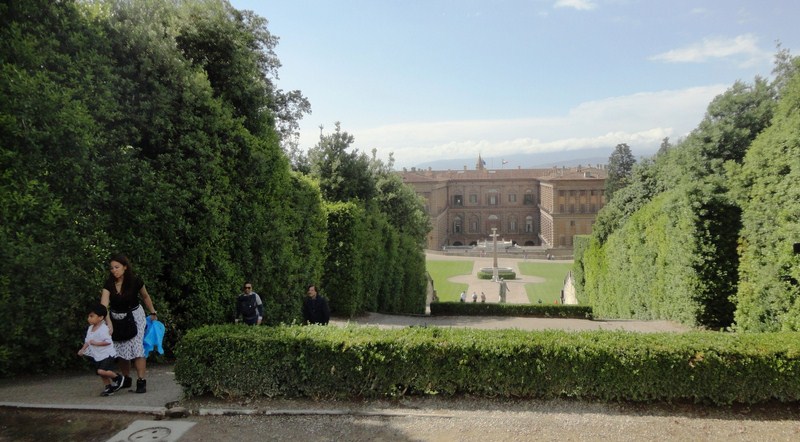From the Pitti Palace (the main seat of the Medici grand dukes), we crossed the Cortile dell’Ammannati (the palace courtyard) and proceeded to the historical Boboli Gardens (Giardini di Boboli) via a staircase that lead to the Artichoke Fountain whose large octagonal basin, decorated with numerous statues of Tritons and Nereids, is crowned by a bronze lily. Begun in 1639 and installed between 1641 and 1642, the fountain is the work of Florentine sculptor Giovan Francesco Susini and his collaborators.
From here, the sight opened up on to the large “amphitheater” of the Boboli Gardens, a park and real outdoor museum behind the palace and the “green lung” of Florence. Opened to the public in 1766, it is home to some of the first and most familiar formal 16th-century Italian gardens, hosting centuries-old oak trees plus a collection of sculptures dating from the 16th through the 18th centuries (with some Roman antiquities).
Representing one of the first and most important examples of the Italian garden, it later served as a prototype and inspiration for many European royal gardens (in particular, Versailles). Just a year before our visit, in 2015, the garden underwent restoration work.
Check out “Versailles Palace”
Developed in the mid-16th-century garden style, it incorporated longer axial developments, wide gravel avenues and a considerable “built” element of stone. Lavishly employing statuary and fountains, its proliferation of detail was coordinated in semi-private and public spaces that were informed by Classical accents such as grottos, nympheums, garden temples and the like. Unconventional for its time, the garden, with it expansive view of the city, was very lavish, considering that no access was allowed (outside of the immediate Medici family) and no entertainment or parties ever took place in the gardens.
The name of the gardens is a corruption of “Borgoli,” the name of the family who laid out the original fields and gardens behind Santa Felicita in the Oltrarno. In 1418, Luca Pitti bought the land from them and, in 1549, the property was purchased by Eleonora di Toledo (the wife of Cosimo I de’ Medici). The land was greatly enlarged to become the Medici family‘s new city residence.
The first stage was scarcely begun by Medici court artist Niccolò Tribolo who drew the original plan before he died the next year in 1550. Under the reign of Francesco I, who succeeded his father Cosimo I, it was continued by Bartolomeo Ammanati, Giorgio Vasari (who contributed in the planning and the laying out of the grottos from 1598 to 1561) and, in the sculpture, by the artist, architect and sculptor Bernardo Buontalenti who was also responsible for the elaborate architecture of the splendid Buontalenti grotto, built between 1536 and 1608, in the courtyard that separates the palace from its garden.
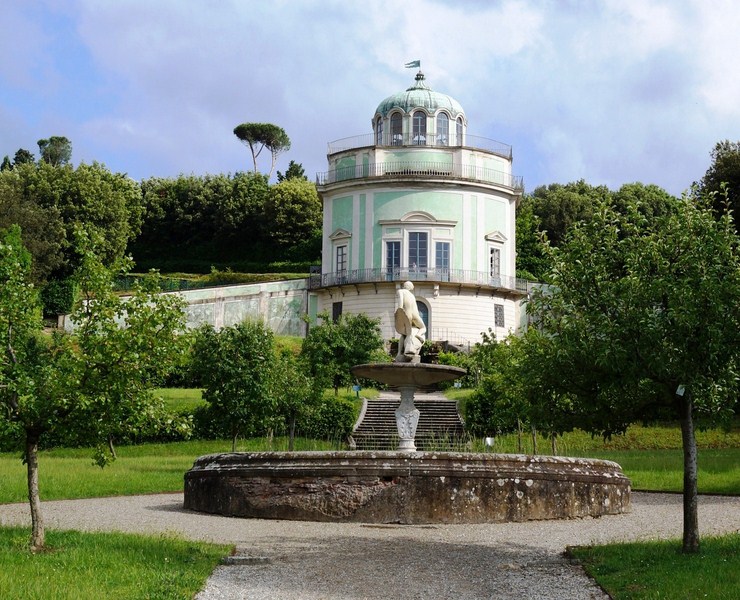
The Kaffeehaus. One of the most interesting buildings inside the Boboli Gardens, it is also one of the works carried out at the wishes of Grand Duke Peter Leopold of Lorraine, between 1774 and 1785. An airy pavilion, it is circular in shape and has an onion-shaped dome on the top. Designed by Zanobi Del Rosso, its interiors were done by Giuseppe del Moro, Giuliano Traballesi and Pasquale Micheli.
Lacking a natural water source to water the plants in the garden, a conduit was built from the nearby Arno River to feed water into an elaborate irrigation system. Passing through several stages of enlargement and restructuring work, the gardens were enlarged in the 17th century to their present extent of 45,000 sq. m. (111 acres).
In the 17th, 18th and 19th centuries, the Medici and the Lorraine families continued to enrich and enlarge the garden, generating an outdoor museum and a scenic setting to exhibit both Roman and 16th and 17th century Renaissance statues. In the 18th century, the Lorraine family made further additions including the green Kaffeehaus (a multiple-tiered garden coffeehouse constructed from 1774 to 1785), with its glazed dome, and the “Lemon House,” both designed by Zanobi del Rosso.
Centered on the rear façade of the Pitti Palace, the primary axis rises on Boboli Hill from a deep amphitheater, behind the corps de logis of the palazzo, that is reminiscent, in its shape, of one half of a classical hippodrome or racecourse. In the first phase of building, the amphitheater was excavated in the hillside behind the palace, initially formed with clipped edges and greens and, later, formalized by rebuilding in stone decorated with statues based on Roman myths.
In 1476, the play Andria by Terence was performed there for the amusement of the cultivated Medici court. Later, it followed by many classically inspired plays, featuring elaborate sets designed by the court architect Baldassarre Lanci, of Florentine playwrights such as Giovan Battista Cini. .
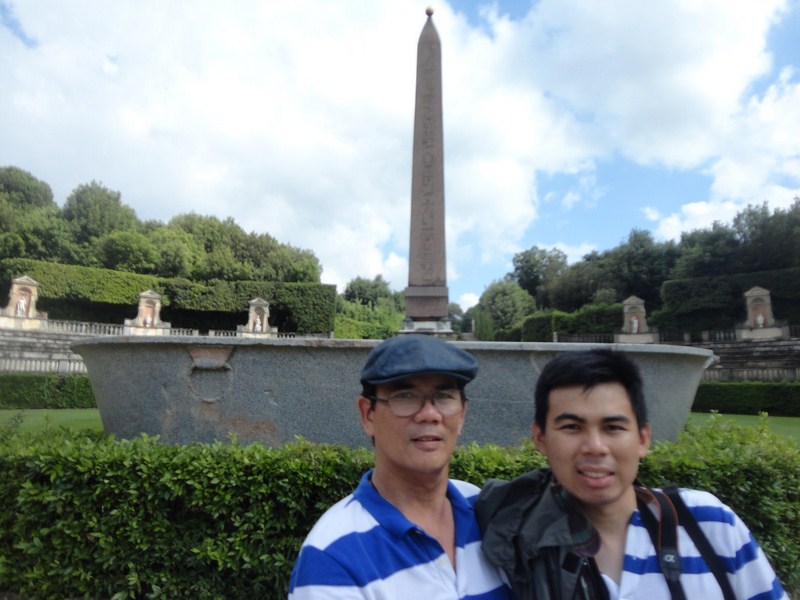
The author and Jandy with the Egyptian obelisk in the background. This obelisk is suspected to have been first erected in the city of Heliopolis during the reign of Ramesses II. In the first century AD, it was moved to Rome by Domitian and placed in the Temple of Isis in the Campus Martius, along with three other obelisks still in Rome. In the sixteenth century, Cardinal Ferdinand I de’ Medici bought the 6 m. high obelisk in Rome and placed it in the gardens of the Villa Medici.
The ancient Egyptian Boboli obelisk, brought here in 1789 from the Villa Medici (in turn, brought there from Luxor) at Rome, is at the center of the amphitheater and is rather dwarfed by its position.
This primary axis terminates in the Neptune Fountain known, to the irreverent Florentines, as the “Fountain of the Fork” for Neptune’s large trident. As we climbed further up the slope, at the very top of the hill, we found the large statue of Abundance, by Giambologna (which featured the likeness of Giovanna of Austria, Francesco I’s wife) visible against the skyline.
The steep, sloping Cyprus Road (or Viottolone, “large avenue”), the long secondary axis a right angle to the primary axis, was laid out by Giulio Parigi. This road, which led up through a series of terraces, tunnels and water features (the main one being the Isolotto complex, with the bosquets on either side), is flanked by cypresses and statuettes and heads back down the hill toward at Porta Romana (Roman Gate), one of the main gates of the walled city. The Grotto of Vulcan (Grotticina di Vulcano), also along this axis, was constructed in 1617 by Parigi.
Check out “Porta Romana“
The oval shaped isolotto, an island in a large, tree-enclosed pond nearly at the end of the alternative Viottolone axis, was laid out around 1618 by Giulio and Alfonso Parigi. It has another fountain of Neptune (here as god of the oceans), known as the Fountain of the Ocean in the center, a replica of the original sculpted by Giambologna which is now in the Bargello Museum. It is surrounded by three sculptures representing the great rivers of the Nile, Ganges and Euphrates.
All around are other statues based on Classic and popular subjects, belonging to the 17th and 18th centuries, like those that shows groups of children playing traditional games. Emerging from the moat surrounding the island are the marble groups, by Giambologna and his pupil, of Perseus on horseback and of Andromeda, whose ankles are chained to the rock.
Check out “Bargello Museum”
Then, we climbed a double staircase, designed in 1793, by Giuseppe del Rosso. It curves around a cylindrical structure topped with a circular terrace, at either side of which stood two statues of the Muses.
Upon reaching the top, we visited the beautiful Knight’s Garden (Giardino del Cavaliere) which stands on an eponymous rampart (Bastione del Cavaliere) built by Michelangelo in 1529.

Giardino del Cavaliere with the Neo-Classical-style Knight’s Building (now housing the Porcelain Museum) on the left
Beside this garden is the Neo-Classical-style Knight’s Building (Palazzina del Cavaliere) housing the Porcelain Museum of the Pitti Palace. Underneath the building is the Trout Reservoir (Conserva delle Trote), a large water storage area, built in 1614, from which the pipes that supply water to the entire garden lead off.
From this colorful garden rich with blossoming roses, we enjoyed a wonderful view of the Torre al Gallo as well as elegant private Florentine manors nearly hidden inside the lavish vegetation of the hills.
Check out “Palazzo Pitti – Porcelain Museum”
The Large Grotto, decorated internally and externally with stalactites and originally equipped with waterworks and luxuriant vegetation, is divided into three main sections decorated with remarkable examples of Mannerist sculptures. The first one, frescoed to create the illusion of a natural grotto, is a natural refuge for shepherds to protect themselves from wild animals.
It originally housed The Prisoners of Michelangelo, statues that were first intended for the tomb of the Pope Julius II and are now in the Gallerie dell’ Accademia. They are now replaced by copies. The third and furthest hall in the grotto contains the famous Bathing Venus of Giambologna and the second section contains Paris Abducts Helen, an 18th-century group by Vincenzo de’ Rossi. These last two chambers were created as the perfect setting for the secretive, amorous meetings of the Duke Francesco I de’ Medici.
Check out “Gallerie dell’ Accademia”
Boboli Gardens: Piazza de’ Pitti, 1, 50125 Florence, Italy. Open from 8:15 AM to 6:30 PM (May, September and October) and 8:15 AM to 7:30 PM (July and August). It is closed the first and last Monday of the month. Admission: €10.



